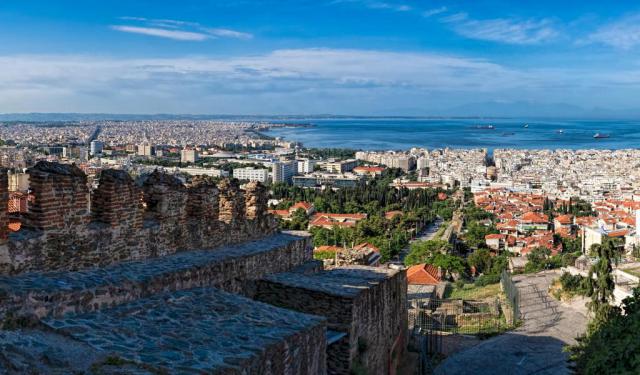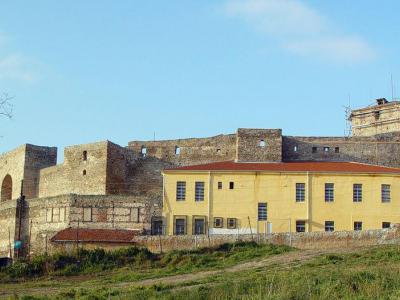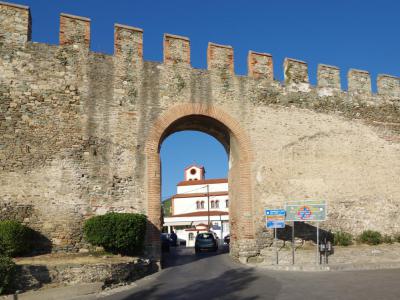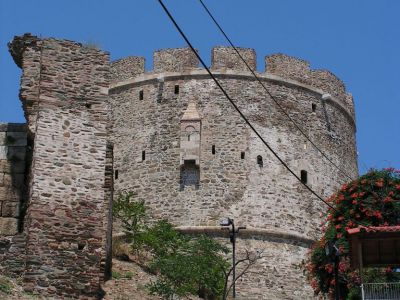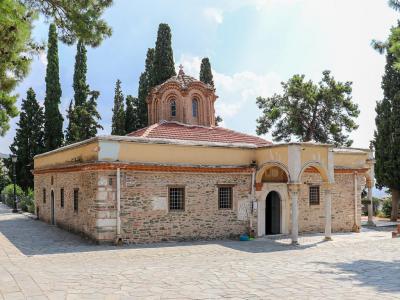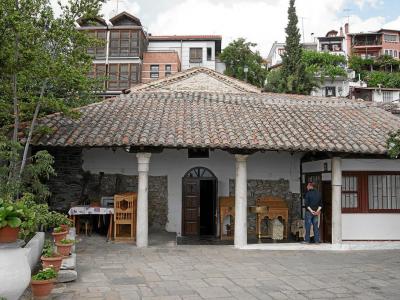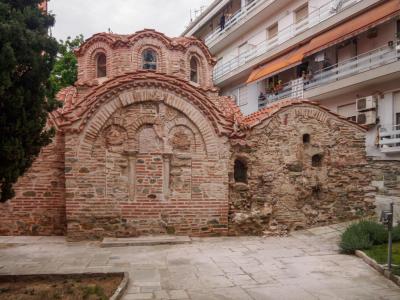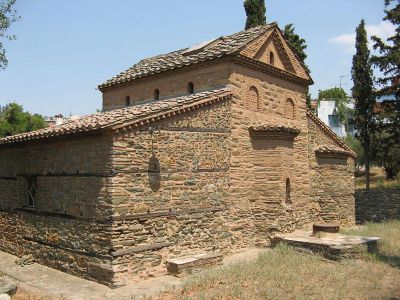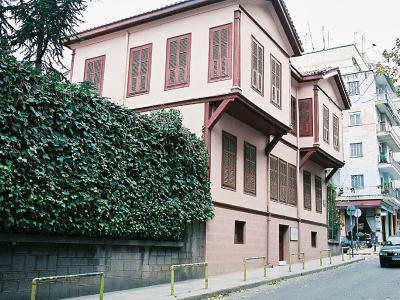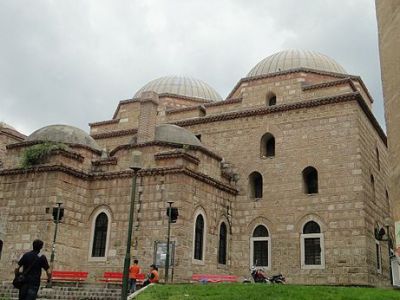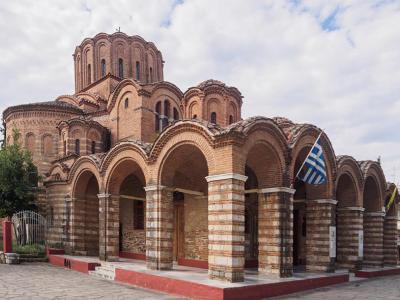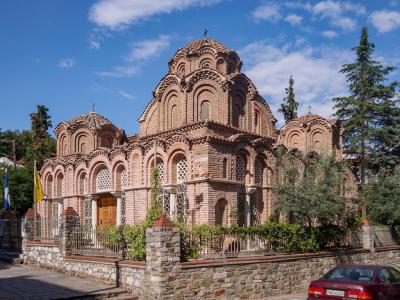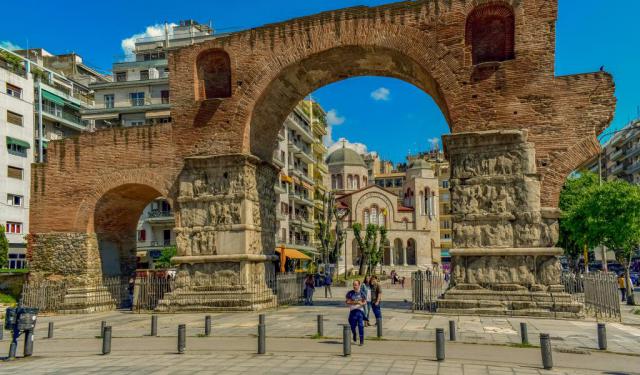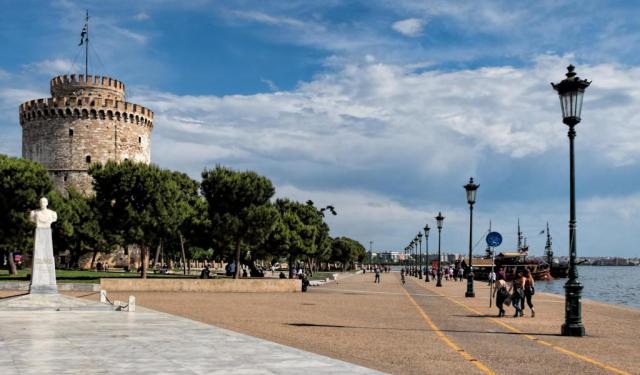Thessaloniki Upper Town Walking Tour (Self Guided), Thessaloniki
Thessaloniki's Upper Town (Ano Poli) is the most ancient part of the city, aged approximately 2,300 years. Being also the highest part of Thessaloniki, dominated by the Acropolis with the Byzantine-/Ottoman-era fort known as Heptapyrgion (Eptapyrgio), from here on a clear day you can see way across the gulf, as far as Mount Olympus, some 80 km (50 miles) away, towering over the horizon in all its splendor.
During the Ottoman rule, Ano Poli was predominantly inhabited by the Turks (Muslims), while the Greeks, western Europeans, and Jews resided in the lower part of the city, around the port. Nowadays, this neighborhood is known for its well-preserved ancient heritage, largely destroyed elsewhere in the city by the Great Fire of 1917, and as such is much favored by intellectuals and bohemian elite. Enclosed within the ancient walls, the charming Ano Poli features a maze of narrow, winding, cobblestone streets lined with traditional Greek and Ottoman-style houses, old squares, quaint alfresco tavernas, and plethora of historic monuments.
World Heritage sites here include the 5th-century Church of Osios David, the 14th-century Vlatadon Monastery, and the 15th-century Trigoniou Tower. Also distinguished for their architectural value are the churches of Profitis (Prophet) Elias, Saint Nicholas Orphanos, and Saint Catherine, as well as the Alaca Imaret Mosque and the Byzantine bath. Still, a standalone attraction in the neighborhood is the Atatürk Museum, showcasing the birthplace of the founder of modern Turkey, Mustafa Kemal Atatürk.
To see what else is Thessaloniki's Upper Town famous for and to explore these and other remnants of great civilizations in the city, take our self-guided walking tour and expand your horizons!
During the Ottoman rule, Ano Poli was predominantly inhabited by the Turks (Muslims), while the Greeks, western Europeans, and Jews resided in the lower part of the city, around the port. Nowadays, this neighborhood is known for its well-preserved ancient heritage, largely destroyed elsewhere in the city by the Great Fire of 1917, and as such is much favored by intellectuals and bohemian elite. Enclosed within the ancient walls, the charming Ano Poli features a maze of narrow, winding, cobblestone streets lined with traditional Greek and Ottoman-style houses, old squares, quaint alfresco tavernas, and plethora of historic monuments.
World Heritage sites here include the 5th-century Church of Osios David, the 14th-century Vlatadon Monastery, and the 15th-century Trigoniou Tower. Also distinguished for their architectural value are the churches of Profitis (Prophet) Elias, Saint Nicholas Orphanos, and Saint Catherine, as well as the Alaca Imaret Mosque and the Byzantine bath. Still, a standalone attraction in the neighborhood is the Atatürk Museum, showcasing the birthplace of the founder of modern Turkey, Mustafa Kemal Atatürk.
To see what else is Thessaloniki's Upper Town famous for and to explore these and other remnants of great civilizations in the city, take our self-guided walking tour and expand your horizons!
How it works: Download the app "GPSmyCity: Walks in 1K+ Cities" from Apple App Store or Google Play Store to your mobile phone or tablet. The app turns your mobile device into a personal tour guide and its built-in GPS navigation functions guide you from one tour stop to next. The app works offline, so no data plan is needed when traveling abroad.
Thessaloniki Upper Town Walking Tour Map
Guide Name: Thessaloniki Upper Town Walking Tour
Guide Location: Greece » Thessaloniki (See other walking tours in Thessaloniki)
Guide Type: Self-guided Walking Tour (Sightseeing)
# of Attractions: 11
Tour Duration: 2 Hour(s)
Travel Distance: 4.0 Km or 2.5 Miles
Author: vickyc
Sight(s) Featured in This Guide:
Guide Location: Greece » Thessaloniki (See other walking tours in Thessaloniki)
Guide Type: Self-guided Walking Tour (Sightseeing)
# of Attractions: 11
Tour Duration: 2 Hour(s)
Travel Distance: 4.0 Km or 2.5 Miles
Author: vickyc
Sight(s) Featured in This Guide:
- Heptapyrgion Fortress
- Portara (Main Gate) and Byzantine Walls of Thessaloniki
- Trigoniou Tower
- Vlatadon Monastery
- Church of Hosios David
- Byzantine Bath
- Church of Saint Nicholas Orphanos
- Atatürk Museum
- Alaca Imaret Mosque
- Church of Prophet Elias
- Ayia Katerini (Church of Saint Catherine)
1) Heptapyrgion Fortress
The Heptapyrgion Fortress is an imposing ancient structure with a long history. The fortress is also known as Yedi Kule. While the name translates to "Fortress of Seven Towers," the fortress actually features ten towers that were built at different times.
The Heptapyrgion's northern towers were either built during the fourth century with Thessaloniki's original walls or during the ninth century. The southern towers were probably built during the 12th century.
The Ottomans conquered Thessaloniki in the 15th century and rebuilt the fortress. Under Ottoman rule, the fort served as the city's military governor's residence.
During the later 19th century, the fortress was converted into a prison. The prison held political prisoners during World War II. In 1989, the prison facilities were relocated.
The Ministry of Culture took over the Heptapyrgion Fortress and began restoration work. Visitors are welcome to explore the eerie fortress and enjoy the fabulous views.
The Heptapyrgion's northern towers were either built during the fourth century with Thessaloniki's original walls or during the ninth century. The southern towers were probably built during the 12th century.
The Ottomans conquered Thessaloniki in the 15th century and rebuilt the fortress. Under Ottoman rule, the fort served as the city's military governor's residence.
During the later 19th century, the fortress was converted into a prison. The prison held political prisoners during World War II. In 1989, the prison facilities were relocated.
The Ministry of Culture took over the Heptapyrgion Fortress and began restoration work. Visitors are welcome to explore the eerie fortress and enjoy the fabulous views.
2) Portara (Main Gate) and Byzantine Walls of Thessaloniki
The Walls of Thessaloniki used to encircle the city from the Middle Ages until 1874 when much of them, especially the parts facing the sea, were destroyed during Ottoman renovations of Thessaloniki.
The remaining section of the Walls dates back to around 390 AD, built during the early Byzantine period, with some parts originating from an earlier construction in the late 3rd century. They're made of the typical late Roman style with alternating layers of stone and brick.
Today, the Walls stretch about 4 kilometers, half of their original length of 8 kilometers, and stand up to 10-12 meters tall and 4.5 meters wide. On the northeast side, they climb up the hills and connect with the Acropolis and Heptapyrgion Fortress.
In 1355, Byzantine Empress Anna Palaiologina modified some parts of the Walls, creating two gates known as Doors to the Walls, and another one to the west called "Portara," meaning Great Gate. These gates provided safe passage for citizens to seek refuge in the Acropolis and Heptapyrgion during attacks or sieges.
The Portara, the main gate, is well-preserved, showing layers of brickwork from repairs done over the centuries. The Walls also feature around 50 towers, including some from the Byzantine era like Klaudianos, Relief, Ormisda, and Andronikos Lapardas towers, as well as those from the Ottoman period such as the White Tower and the Chain/Triangle Tower. The Walls of Thessaloniki are recognized as a UNESCO World Heritage Site.
The remaining section of the Walls dates back to around 390 AD, built during the early Byzantine period, with some parts originating from an earlier construction in the late 3rd century. They're made of the typical late Roman style with alternating layers of stone and brick.
Today, the Walls stretch about 4 kilometers, half of their original length of 8 kilometers, and stand up to 10-12 meters tall and 4.5 meters wide. On the northeast side, they climb up the hills and connect with the Acropolis and Heptapyrgion Fortress.
In 1355, Byzantine Empress Anna Palaiologina modified some parts of the Walls, creating two gates known as Doors to the Walls, and another one to the west called "Portara," meaning Great Gate. These gates provided safe passage for citizens to seek refuge in the Acropolis and Heptapyrgion during attacks or sieges.
The Portara, the main gate, is well-preserved, showing layers of brickwork from repairs done over the centuries. The Walls also feature around 50 towers, including some from the Byzantine era like Klaudianos, Relief, Ormisda, and Andronikos Lapardas towers, as well as those from the Ottoman period such as the White Tower and the Chain/Triangle Tower. The Walls of Thessaloniki are recognized as a UNESCO World Heritage Site.
3) Trigoniou Tower
The Trigonion Tower is the Byzantine city wall's most famous tower. It is part of Thessaloniki's UNESCO World Heritage Site. It was built to reinforce an artillery tower after the Turkish occupation began in 1430. The tower's location was strategically important as this portion of the wall when Thessaloniki faced heavy attacks.
During Ottoman rule, the tower was also called Chain Tower or Belted Tower due to a relief in the central section that looks like a belt. It was used as an artillery tower and an armory. The tower is 22 meters (72.2 feet) tall and 24 meters (78.7 feet) in diameter.
The Trigonion Tower is also known as Thessaloniki's balcony. It provides an excellent view of the city's acropolis. In addition, visitors can enjoy a panoramic view of the old city and the Gulf of Thermaikos. On clear days, visitors can see Mount Olympus 150 kilometers away. Visitors and locals alike often gather here to watch the sunset.
Visitors can stop at a nearby cafe for refreshments before continuing their walk.
During Ottoman rule, the tower was also called Chain Tower or Belted Tower due to a relief in the central section that looks like a belt. It was used as an artillery tower and an armory. The tower is 22 meters (72.2 feet) tall and 24 meters (78.7 feet) in diameter.
The Trigonion Tower is also known as Thessaloniki's balcony. It provides an excellent view of the city's acropolis. In addition, visitors can enjoy a panoramic view of the old city and the Gulf of Thermaikos. On clear days, visitors can see Mount Olympus 150 kilometers away. Visitors and locals alike often gather here to watch the sunset.
Visitors can stop at a nearby cafe for refreshments before continuing their walk.
4) Vlatadon Monastery
Vlatadon Monastery is part of the Ano Poli Upper Town. Its also known as the Monastery of the Vlatades. When it was founded, it was called the Monastery of the Pantocrator. It was built during the 14th century during the end of the Byzantine Empire. It's part of Thessaloniki's UNESCO World Heritage Site.
Dorotheus and Markus Vlatadon founded the monastery in 1351. Historians believe the monastery was built on the same site that the Apostle Paul preached in AD 51. In 1351, Empress Anna Palaiologos retired to Thessalonica and gave the monastery its royal status.
Ottoman Turks began occupying the monastery in 1387. The main church was converted into a mosque, and the Turks plastered over the interior frescoes. Turkish troops billeted in the monastery during this time. When the Turks left in 1403, the monastery was returned to its original purpose. The Turks returned in 1430 but did not sequester the monastery again.
The monastery was renovated throughout the 20th century. The Patriarchal Institute for Patristic Studies operates in the monastery.
Several of the monastery's arches, semi-columns, and pediments are original. Most of the frescoes date to the 14th century. The monastery houses an extensive collection of Byzantine religious icons, scripts, codecs, patriarchal sigillum, and imperial golden seals.
The monastery is 120 meters (394 feet) above sea level and offers beautiful city and sea views.
Dorotheus and Markus Vlatadon founded the monastery in 1351. Historians believe the monastery was built on the same site that the Apostle Paul preached in AD 51. In 1351, Empress Anna Palaiologos retired to Thessalonica and gave the monastery its royal status.
Ottoman Turks began occupying the monastery in 1387. The main church was converted into a mosque, and the Turks plastered over the interior frescoes. Turkish troops billeted in the monastery during this time. When the Turks left in 1403, the monastery was returned to its original purpose. The Turks returned in 1430 but did not sequester the monastery again.
The monastery was renovated throughout the 20th century. The Patriarchal Institute for Patristic Studies operates in the monastery.
Several of the monastery's arches, semi-columns, and pediments are original. Most of the frescoes date to the 14th century. The monastery houses an extensive collection of Byzantine religious icons, scripts, codecs, patriarchal sigillum, and imperial golden seals.
The monastery is 120 meters (394 feet) above sea level and offers beautiful city and sea views.
5) Church of Hosios David
The Church of Hosios David was built in the 5th century. It was part of the Latomos Monastery during Byzantine times. The church was built in a cross pattern with square bays in the corners.
The Church of Hosios David was converted into a mosque during Ottoman rule. The Ottomans added a minaret to the converted mosque. Today, only the minaret's base and spiral staircase remain. In 1921, it was reconsecrated as a Greek Orthodox Church. The Church of Hosios David is part of Thessaloniki's UNESCO World Heritage Site.
Many of the frescoes and decorations have been damaged by earthquakes and the plaster coverings used during Ottoman rule. However, many beautiful mosaics and frescoes remain. For example, the stunning Theophany mosaic features Christ holding a text, surrounded by Evangelists.
Murals from the 12th and 13th centuries depict the nativity, Christ's baptism, our lady of the passion, Christ's entry into Jerusalem, and many decorative panels.
The Church of Hosios David was converted into a mosque during Ottoman rule. The Ottomans added a minaret to the converted mosque. Today, only the minaret's base and spiral staircase remain. In 1921, it was reconsecrated as a Greek Orthodox Church. The Church of Hosios David is part of Thessaloniki's UNESCO World Heritage Site.
Many of the frescoes and decorations have been damaged by earthquakes and the plaster coverings used during Ottoman rule. However, many beautiful mosaics and frescoes remain. For example, the stunning Theophany mosaic features Christ holding a text, surrounded by Evangelists.
Murals from the 12th and 13th centuries depict the nativity, Christ's baptism, our lady of the passion, Christ's entry into Jerusalem, and many decorative panels.
6) Byzantine Bath
The Byzantine Bath of Thessaloniki stands as the lone survivor among the city's ancient bathhouses and ranks among Greece's most well-preserved relics from antiquity. Constructed in the late 12th or early 13th century, it remained operational until 1940, when it ceased operations, likely due to the upheavals of World War II and the German occupation of Greece. Originally believed to be part of a monastery complex, during Ottoman rule it came to be known as Kule Hammam, or the "Bath of the Citadel".
Reflecting Roman architectural conventions, the bathhouse features an entrance to the south leading to the frigidarium, or dressing rooms, followed by two tepidarium, or warm rooms, distinguished by their vaulted ceilings, and two caldarium, or hot rooms, both equipped with hypocaust heating systems. Adjacent to the bathhouse to the north was a cistern heated by a hearth beneath it, ensuring a supply of hot water.
Throughout its extensive history of use, the original structure underwent numerous modifications. While in the Byzantine era, it was utilized by both men and women interchangeably, under Ottoman rule, it was partitioned into segregated sections for each gender by blocking off pairs of rooms.
After its closure in 1940, the bathhouse suffered neglect and damage during the earthquakes of 1978, surviving largely due to the efforts of the 9th Ephorate of Byzantine Antiquities and protection provided by an external metal sheet. Recognizing its significance, UNESCO added the Bath of Thessaloniki to its list of World Heritage Sites in 1988, alongside other Paleochristian and Byzantine monuments in the city.
Following extensive restoration efforts spanning four years, the bathhouse was reopened to the public in June 2015, serving as both a museum and cultural venue.
Reflecting Roman architectural conventions, the bathhouse features an entrance to the south leading to the frigidarium, or dressing rooms, followed by two tepidarium, or warm rooms, distinguished by their vaulted ceilings, and two caldarium, or hot rooms, both equipped with hypocaust heating systems. Adjacent to the bathhouse to the north was a cistern heated by a hearth beneath it, ensuring a supply of hot water.
Throughout its extensive history of use, the original structure underwent numerous modifications. While in the Byzantine era, it was utilized by both men and women interchangeably, under Ottoman rule, it was partitioned into segregated sections for each gender by blocking off pairs of rooms.
After its closure in 1940, the bathhouse suffered neglect and damage during the earthquakes of 1978, surviving largely due to the efforts of the 9th Ephorate of Byzantine Antiquities and protection provided by an external metal sheet. Recognizing its significance, UNESCO added the Bath of Thessaloniki to its list of World Heritage Sites in 1988, alongside other Paleochristian and Byzantine monuments in the city.
Following extensive restoration efforts spanning four years, the bathhouse was reopened to the public in June 2015, serving as both a museum and cultural venue.
7) Church of Saint Nicholas Orphanos
The Church of Saint Nicholas Orphanos was originally built in the early 14th century as part of a monastery.
Serbian king Stephen Uros II Milutin sponsored several churches in Thessaloniki and might have sponsored the Church of Saint Nicholas Orphanos. Milutin's patron saint, Saint George Gorgos, is depicted in a fresco in the church's main aisle. Another fresco features Saint Clemens of Ohrid, who was often depicted in Serbian churches.
The Church of Saint Nicholas Orphanos avoided conversion during Ottoman rule. This is probably because the church is relatively small, humble, and out of the way.
The small, simple church originally had a wooded gabled roof. The exterior features brick and stone in irregular layers. A small walled garden provides a delightful place for contemplation.
The interior features the church's original marble templon. The church's most impressive feature is its original frescoes covering the walls. The frescoes show various narrative scenes showing Christ's life and miracles. The frescoes also feature scenes from the life of Saint Nicholas.
Serbian king Stephen Uros II Milutin sponsored several churches in Thessaloniki and might have sponsored the Church of Saint Nicholas Orphanos. Milutin's patron saint, Saint George Gorgos, is depicted in a fresco in the church's main aisle. Another fresco features Saint Clemens of Ohrid, who was often depicted in Serbian churches.
The Church of Saint Nicholas Orphanos avoided conversion during Ottoman rule. This is probably because the church is relatively small, humble, and out of the way.
The small, simple church originally had a wooded gabled roof. The exterior features brick and stone in irregular layers. A small walled garden provides a delightful place for contemplation.
The interior features the church's original marble templon. The church's most impressive feature is its original frescoes covering the walls. The frescoes show various narrative scenes showing Christ's life and miracles. The frescoes also feature scenes from the life of Saint Nicholas.
8) Atatürk Museum
The Atatürk Museum in Thessaloniki is an important historical site as it marks the birthplace of Mustafa Kemal Atatürk, the renowned figure behind the establishment of modern Turkey, born there in 1881. The building itself, consisting of three floors and a courtyard, dates back to before 1870.
In 1935, the Thessaloniki City Council handed over the property to the Turkish State, which opted to transform it into a museum. Unfortunately, in September 1955, a bomb blast near the nearby Turkish consulate caused some damage to the museum building. Though the damage was relatively minor, it triggered an anti-Greek violence wave in Istanbul. Later on, Turkish Prime Minister Adnan Menderes was ousted, and his government was held responsible for orchestrating the bombing by a Turkish court. Menderes, acknowledging the wrongdoing, offered apologies and compensation, yet he was sentenced to death, with one of the charges being his alleged encouragement of the Istanbul violence. Consequently, the street in front of the house, originally named after Kemal Ataturk, underwent a name change.
The museum underwent restoration in 1981, during which it was repainted its original pink hue. Much of the furniture on display inside is authentic, offering visitors a glimpse into the past. The first floor showcases various rooms including a reception area, a sitting room, Kemal's mother's room, and the kitchen. On the second floor, visitors can view the actual room where Kemal was born, along with another room exhibiting some of his personal belongings such as formal attire, smoking accessories, utensils, cups, and more.
The walls are adorned with documents from Kemal's school years and photographs spanning his lifetime. Additionally, a pomegranate tree planted by Kemal's father still stands in the courtyard, adding to the historical ambiance. Additionally, in 1981, a replica of the house was constructed in Ankara, further honoring Kemal Atatürk's legacy.
In 1935, the Thessaloniki City Council handed over the property to the Turkish State, which opted to transform it into a museum. Unfortunately, in September 1955, a bomb blast near the nearby Turkish consulate caused some damage to the museum building. Though the damage was relatively minor, it triggered an anti-Greek violence wave in Istanbul. Later on, Turkish Prime Minister Adnan Menderes was ousted, and his government was held responsible for orchestrating the bombing by a Turkish court. Menderes, acknowledging the wrongdoing, offered apologies and compensation, yet he was sentenced to death, with one of the charges being his alleged encouragement of the Istanbul violence. Consequently, the street in front of the house, originally named after Kemal Ataturk, underwent a name change.
The museum underwent restoration in 1981, during which it was repainted its original pink hue. Much of the furniture on display inside is authentic, offering visitors a glimpse into the past. The first floor showcases various rooms including a reception area, a sitting room, Kemal's mother's room, and the kitchen. On the second floor, visitors can view the actual room where Kemal was born, along with another room exhibiting some of his personal belongings such as formal attire, smoking accessories, utensils, cups, and more.
The walls are adorned with documents from Kemal's school years and photographs spanning his lifetime. Additionally, a pomegranate tree planted by Kemal's father still stands in the courtyard, adding to the historical ambiance. Additionally, in 1981, a replica of the house was constructed in Ankara, further honoring Kemal Atatürk's legacy.
9) Alaca Imaret Mosque
The Alaca Imaret Mosque, also known as the Ishak Pasha Mosque, is a mosque from the 15th century under Ottoman rule. According to an inscription found at its entrance, the mosque was established in February 1484 by the command of Inogiolou Ishak Pasha, who served as the Grand Vizier during the reigns of Mohammed II and Bayezid II.
Besides its primary function as a place of worship, the mosque also housed facilities such as an imaret, a public charity kitchen, and a medrese, a religious school. By the 17th century, the Alaca Imaret had risen to prominence and became one of the city's notable institutions.
The mosque follows the architectural style typical of early Ottoman structures, featuring an inverted T-shape layout with a central area, two large domes, side chambers on the western side, and a colonnaded portico with five smaller domes. Historically, the central space was designated for prayers, while the surrounding areas were utilized for educational activities and communal meals. Inside, a significant arch divides the space into two square sections, each covered by a dome.
Originally, the mosque boasted lavish interior decoration including murals adorning the domes and walls, along with Quranic inscriptions. The name "Alaja Imaret" derives from the colorful, rhomboid-shaped stones (alaça) that once embellished the mosque's minaret. Unfortunately, the minaret was destroyed after Thessaloniki was recaptured by the Greeks in 1912, leaving only its base intact.
In 1970, following the collapse of the northern part of the portico, maintenance works commenced for the first time. Further restoration efforts took place between 1993 and 1996, focusing on the intricate external masonry among other tasks. Presently, the municipality of Thessaloniki owns the building, which no longer serves as a mosque but instead functions as an exhibition space.
Besides its primary function as a place of worship, the mosque also housed facilities such as an imaret, a public charity kitchen, and a medrese, a religious school. By the 17th century, the Alaca Imaret had risen to prominence and became one of the city's notable institutions.
The mosque follows the architectural style typical of early Ottoman structures, featuring an inverted T-shape layout with a central area, two large domes, side chambers on the western side, and a colonnaded portico with five smaller domes. Historically, the central space was designated for prayers, while the surrounding areas were utilized for educational activities and communal meals. Inside, a significant arch divides the space into two square sections, each covered by a dome.
Originally, the mosque boasted lavish interior decoration including murals adorning the domes and walls, along with Quranic inscriptions. The name "Alaja Imaret" derives from the colorful, rhomboid-shaped stones (alaça) that once embellished the mosque's minaret. Unfortunately, the minaret was destroyed after Thessaloniki was recaptured by the Greeks in 1912, leaving only its base intact.
In 1970, following the collapse of the northern part of the portico, maintenance works commenced for the first time. Further restoration efforts took place between 1993 and 1996, focusing on the intricate external masonry among other tasks. Presently, the municipality of Thessaloniki owns the building, which no longer serves as a mosque but instead functions as an exhibition space.
10) Church of Prophet Elias
The Church of Prophet Elijah, situated in Thessaloniki, stands as a testament to the city's rich historical and architectural heritage. Dating back to the 14th century, this church holds significance not only for its religious importance but also as a UNESCO World Heritage Site.
Originally constructed during the Palaiologan period, the church's original dedication remains unknown. During the Ottoman era, it was referred to as the Saraylı Mosque, a name derived from its proximity to a palace or court. However, a misinterpretation of this name led to its modern dedication to the Prophet Elijah.
While traditionally believed to be a catholic monastery, recent research has cast doubt on this assertion. Evidence suggests that the church of Prophet Elijah was converted into a mosque by Badrah Mustafa Pasha soon after the city's capture in 1430. Some scholars propose that it might have been associated with the Akapniou Monastery based on its internal decoration.
Architecturally, the Church of Prophet Elijah showcases a unique variant of the cross-in-square design, known as the "Athonite type." This architectural style, reserved typically for the catholic monastery, distinguishes it from other structures in Thessaloniki. The meticulous masonry, characterized by alternating courses of bricks and white ashlar, reflects influences from Constantinopolitan architecture.
One of the church's notable features is its internal decoration, including fragments of original wall paintings. These artworks, exemplary of late Palaiologan art, have influenced later paintings in regions such as Serbia. Moreover, the architectural features of the church have been interpreted to create an ambient atmosphere conducive to worship, particularly through the distribution of natural light.
Despite the passage of centuries and various transformations, the Church of Prophet Elijah continues to stand as a testament to Thessaloniki's cultural richness and architectural ingenuity.
Originally constructed during the Palaiologan period, the church's original dedication remains unknown. During the Ottoman era, it was referred to as the Saraylı Mosque, a name derived from its proximity to a palace or court. However, a misinterpretation of this name led to its modern dedication to the Prophet Elijah.
While traditionally believed to be a catholic monastery, recent research has cast doubt on this assertion. Evidence suggests that the church of Prophet Elijah was converted into a mosque by Badrah Mustafa Pasha soon after the city's capture in 1430. Some scholars propose that it might have been associated with the Akapniou Monastery based on its internal decoration.
Architecturally, the Church of Prophet Elijah showcases a unique variant of the cross-in-square design, known as the "Athonite type." This architectural style, reserved typically for the catholic monastery, distinguishes it from other structures in Thessaloniki. The meticulous masonry, characterized by alternating courses of bricks and white ashlar, reflects influences from Constantinopolitan architecture.
One of the church's notable features is its internal decoration, including fragments of original wall paintings. These artworks, exemplary of late Palaiologan art, have influenced later paintings in regions such as Serbia. Moreover, the architectural features of the church have been interpreted to create an ambient atmosphere conducive to worship, particularly through the distribution of natural light.
Despite the passage of centuries and various transformations, the Church of Prophet Elijah continues to stand as a testament to Thessaloniki's cultural richness and architectural ingenuity.
11) Ayia Katerini (Church of Saint Catherine)
The Church of Saint Catherine, known locally as Agia Aikaterini, stands as a testament to the rich Byzantine heritage of Thessaloniki. Situated in the north-western part of Ano Poli, within the historic confines of the city and near the ancient fortress walls, this architectural marvel dates back to the late 13th to early 14th centuries.
Originally constructed during the Paleologian era, the precise Byzantine name of the church has been lost to history. However, it is believed to have been the main temple of the monastery of Christ the Almighty, dedicated to Christ himself. The church is particularly notable for housing a relic of Agia Aikaterini, a significant martyr of the Christian faith, in the form of her wrist bone.
Throughout its existence, the Church of Saint Catherine has undergone several transformations. Under Ottoman rule, it was converted into a mosque by Bayezid II. However, efforts to restore its original purpose and grandeur began in earnest in the mid-20th century. Significant restoration work took place between 1947 and 1951, which revealed hidden frescoes dating back to the early 14th century, shedding light on its Byzantine past.
Architecturally, the church is a stunning example of Byzantine design, featuring a cross-domed layout with two symmetrical chapels on its eastern side and five domes, including a central dome atop the main nave and four smaller ones at the corners of the peristyle. The exterior showcases intricate stonework adorned with luxurious ornamentation, such as zigzag passageways, blind arches, half-columns, and ceramic embellishments, all displaying the remarkable construction expertise of the Byzantine era.
Inside, the church is adorned with frescoes dating back to the 14th century. These include depictions of bishops, the assembly of apostles, prophets, angels, and scenes from Christ's miracles. Though some of these artworks have been damaged or destroyed over time, the Church of Saint Catherine remains a treasure trove of Byzantine religious art and history, attracting visitors from around the world to marvel at its beauty and significance within the cultural tapestry of Thessaloniki.
Originally constructed during the Paleologian era, the precise Byzantine name of the church has been lost to history. However, it is believed to have been the main temple of the monastery of Christ the Almighty, dedicated to Christ himself. The church is particularly notable for housing a relic of Agia Aikaterini, a significant martyr of the Christian faith, in the form of her wrist bone.
Throughout its existence, the Church of Saint Catherine has undergone several transformations. Under Ottoman rule, it was converted into a mosque by Bayezid II. However, efforts to restore its original purpose and grandeur began in earnest in the mid-20th century. Significant restoration work took place between 1947 and 1951, which revealed hidden frescoes dating back to the early 14th century, shedding light on its Byzantine past.
Architecturally, the church is a stunning example of Byzantine design, featuring a cross-domed layout with two symmetrical chapels on its eastern side and five domes, including a central dome atop the main nave and four smaller ones at the corners of the peristyle. The exterior showcases intricate stonework adorned with luxurious ornamentation, such as zigzag passageways, blind arches, half-columns, and ceramic embellishments, all displaying the remarkable construction expertise of the Byzantine era.
Inside, the church is adorned with frescoes dating back to the 14th century. These include depictions of bishops, the assembly of apostles, prophets, angels, and scenes from Christ's miracles. Though some of these artworks have been damaged or destroyed over time, the Church of Saint Catherine remains a treasure trove of Byzantine religious art and history, attracting visitors from around the world to marvel at its beauty and significance within the cultural tapestry of Thessaloniki.
Walking Tours in Thessaloniki, Greece
Create Your Own Walk in Thessaloniki
Creating your own self-guided walk in Thessaloniki is easy and fun. Choose the city attractions that you want to see and a walk route map will be created just for you. You can even set your hotel as the start point of the walk.
Thessaloniki Introduction Walking Tour
Thessaloniki is Greece's second-largest city as well as its second major political, industrial, commercial, and economic center.
Historically, Thessaloniki co-ruled the Byzantine Empire along with Constantinople. But its history goes back even further than that. Cassander of Macedon originally founded the city in 315 BC. Cassander named the city after his wife, Thessalonike. Thessalonike... view more
Tour Duration: 2 Hour(s)
Travel Distance: 3.7 Km or 2.3 Miles
Historically, Thessaloniki co-ruled the Byzantine Empire along with Constantinople. But its history goes back even further than that. Cassander of Macedon originally founded the city in 315 BC. Cassander named the city after his wife, Thessalonike. Thessalonike... view more
Tour Duration: 2 Hour(s)
Travel Distance: 3.7 Km or 2.3 Miles
Thessaloniki Waterfront Tour
The Mediterranean has always been an integral part of Thessaloniki’s appeal. The city's orientation toward the sea is largely due to the vision of Ernest Hébrard, the French urban planner and architect, who redesigned the downtown area after the devastating fire of 1917.
To really get the taste of Thessaloniki you need to visit not just its historical landmarks, but also those spots... view more
Tour Duration: 1 Hour(s)
Travel Distance: 2.6 Km or 1.6 Miles
To really get the taste of Thessaloniki you need to visit not just its historical landmarks, but also those spots... view more
Tour Duration: 1 Hour(s)
Travel Distance: 2.6 Km or 1.6 Miles
The Most Popular Cities
/ view all
